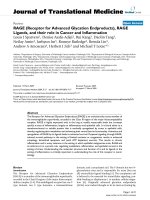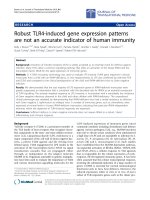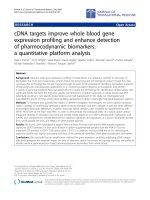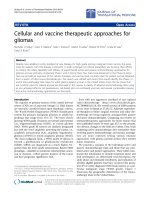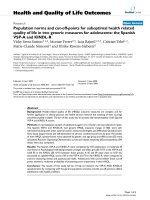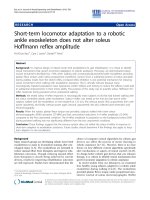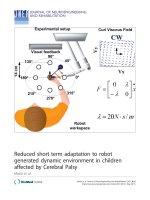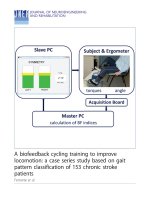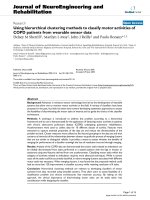báo cáo hóa học: " Toll-like receptor 2 -196 to -174 del polymorphism influences the susceptibility of Han Chinese people to Alzheimer’s disease" potx
Bạn đang xem bản rút gọn của tài liệu. Xem và tải ngay bản đầy đủ của tài liệu tại đây (219.74 KB, 4 trang )
SHOR T REPOR T Open Access
Toll-like receptor 2 -196 to -174 del
polymorphism influences the susceptibility of
Han Chinese people to Alzheimer’s disease
Jin-Tai Yu
1,2†
, Shan-Mao Mou
1,3†
, Li-Zhu Wang
4
, Cai-Xia Mao
1,3
and Lan Tan
1,2*
Abstract
Background: Toll-like receptor 2 (TLR2) represents a reasonable functional and positional candidate gene for
Alzheimer’s disease (AD) as it is located under the linkage region of AD on chromosome 4q, and functionally is
involved in the microglia-mediated inflammatory response and amyloid-b clearance. The -196 to -174 del
polymorphism affects the TLR2 gene and alters its promoter activity.
Methods: We recruited 800 unrelated Northern Han Chinese individuals comprising 400 late-onset AD (LOAD)
patients and 400 healthy controls matched for gender and age. The -196 to -174 del polymorphism in the TLR2
gene was genotyped using the polymerase chain reaction (PCR) method.
Results: There were significant differences in genotype (P = 0.026) and allele (P = 0.009) frequencies of the -196 to
-174 del polymorphism between LOAD patients and controls. The del allele was associated with an increased risk
of LOAD (OR = 1.31, 95% CI = 1.07-1.60, Power = 84.9%). When these data were stratified by apolipoprotein E
(ApoE) ε4 status, the observed association was confined to ApoE ε4 non-carriers. Logistic regression analysis
suggested an association of LOAD with the polymorphism in a recessive model (OR = 1.64, 95% CI = 1.13-2.39,
Bonferroni corrected P = 0.03).
Conclusions: Our data suggest that the -196 to -174 del/del genotype of TLR2 may increase risk of LOAD in a
Northern Han Chinese population.
Keywords: Alzheimer’s disease, toll-like receptor 2, polymorphism, association study
Background
Toll-like receptor 2 (TLR2) represents a reasonable
functional and positional candidate gene for Alzheimer’s
disease (AD) as it is located under the link age region of
AD on chromosome 4q [1], and is functionally involved
in the microglia-mediated inflammatory response and
amyloid b (Ab) clearance [2-6]. Genetic studies on the
TLR2 gene have identified a number of polymorphisms
which have been shown to affect host defense, disease
progression and be linked to differential disease suscept-
ibilities [7]. We have assessed the involvement of 7 sin-
glenucleotidepolymorphisms(SNPs)(Arg677Trp,
Arg753Gln, rs1898830, rs11938228, rs3804099,
rs3804100, and rs7656411) as well as a short tandem
GT repeat polymorphism in intron 2 of the TLR2 gene
in the risk of developing late-onset AD (LOAD) [8,9],
and found an association of GT repeat polymorphism
with an increased risk for LOAD in our previous stu-
dies. A 22-bp nucleotide deletion at po sition -196 to
-174 of the untranslated 5’-re gion in TLR2 gene is asso-
ciated with reduced transcript ional activity compared to
the wild type allele in luciferase reporter assays [10].
This polymorphism has already been shown to be asso-
ciated with an increased risk of noncardiac gastric can-
cer, susceptibility to cervical cancer, hepatitis C viral
loads and susceptibility to hepatocellular carcinoma
[11-13]. In light of the important role that TLR2 plays
with respect to the immune response in the pathogen-
esis of AD [2-6], we hypothesized that the -196 to -174
* Correspondence:
† Contributed equally
1
Department of Neurology, Qingdao Municipal Hospital, School of Medicine,
Qingdao University, No.5 Donghai Middle Road, Qingdao 266071, China
Full list of author information is available at the end of the article
Yu et al. Journal of Neuroinflammation 2011, 8:136
/>JOURNAL OF
NEUROINFLAMMATION
© 2011 Yu et al; licensee BioMed Central Ltd. This is an Open Access article distri buted under the terms of the Creative Commons
Attribution License (http://creativecomm ons.org/licenses/by/2.0), which permits unrestricted use, distribution, and reproductio n in
any medium, provided the original work is prop erly cited.
del/ins polymorphism in the TLR2 gene might be asso-
ciated with AD.
Methods
Subjects
Our study was comprised of 400 sporadic LOAD cases
(189 female and 211 male; age > 65 years; mean age =
82.8 ± 7.1 years; age at onset = 75.4 ± 5 .9 years) and
400 healthy controls subjects matched for sex and age
(189 female and 211 male; mean age = 81.4 ± 5.4 years).
All participants originated from Northern Han Chinese
populations. A clinical diagnosis of probable AD was
established according to the criteria of National Institute
of Neurological and Communicative Disorders and
Stroke and the Alzheimer’s disease and Related Disor-
ders Association (NINCDS-ADRDA) [14]. All AD cases
were defined as sporadic because family histories
showed no mention of first-degree relatives with demen-
tia. Control subjects were unrelated individuals selected
from the Health Examination Center of the Qingdao
Municipal Hospital. The se subjects we re confirmed
healthy and neurologically normal by complete neurolo-
gical and medical examinations comprised of medical
history and laboratory examinations. Written informed
consent was o btained from all individuals and the study
was approved by the Institute Ethical Committee.
Genotyping
Genomic DNA was extracted from peripheral blood leu-
kocytes using the standard method [15]. Polymorphisms
at TLR2 -196 to -174del were investigated using the
polymerase chain reaction (PCR) method, following the
procedures described by Tahara et al [11]. The apolipo-
protein E (ApoE) genotype was determined according to
the method described by Donohoe et al [16]. Two inves-
tigators independently reviewed all results.
Statistical analysis
Hardy-Weinberg equilibrium was assessed using the
Chi-square test. Genotype and allele distributions were
compared using the Chi-square test. Differences in
allele and genotype distribution between cases and
controls were analyzed using logistic regression
adjusted for age and ApoE ε 4statusundervarious
genetic models. The Wald P value was multiplied by 3
as a Bonferroni adjustment for the 3 genetic models
tested.ThePvalue,oddsratios(OR)and95%confi-
dence intervals (CI) were calculated. Estimation of the
statistical power was performed with the STPLAN 4.3
software.Datawereanalyzedusingacommercially
available statistical package (SPSS Version 13.0, SPSS
Inc., Chicago, IL). The criterion used for significant
differences is P < 0.05.
Results
The alleles and genotypes frequencies of LOAD patients
and controls in the total sample and after stratification for
ApoE ε4 allele are given in Table 1. The distribution of
genotypes of TLR2 polymorphisms were within the range
of Hardy-Weinberg equilibrium (P = 0.21). There were
significant differences in genotype and allele frequencies
between LOA D and control groups (genotyp e P = 0.026,
all ele P = 0.009). The -196 to -174 del allele significantly
raised the risk of developing LOAD (OR = 1.31, 95%CI =
1.07-1.60, Power = 84.9%). In subjects without ApoE ε4
allele, the allele and genotype distributions between
LOAD patients and controls remain significantly different
(genotype P = 0.027, allele P = 0.009). However, in subjects
with the ApoE ε4 allele, there were no significant differ-
ences. In order to rule out confounding in our crude asso-
ciation analyses, we reevaluated the polymorphism effect
under 3 different model s using logistic regression adjust-
ing for age and ApoE ε4 status (Table 2). The -196 to -174
del polymorphism w as still found to increase the risk of
LOADviaarecessivemodel(OR=1.64,95%CI=1.13-
2.39, P = 0.01, Bonferroni corrected P = 0.03).
Discussion
Many experimental and clinical studies have suggested
that TLR2 might play an important role in the
Table 1 Distribution of the TLR2 -196 to -174 del polymorphism in LOAD cases and controls.
N Genotypes n (%) Alleles n (%)
ins/ins del/ins del/del P del ins P
AD 400 150(37.5) 161(40.2) 89(22.2) 0.026 461(57.6) 339(42.4) 0.009
Controls 400 172(43.0) 168(42.0) 60(15.0) 512(64.0) 288(36.0)
ApoEε4(-)
AD 260 94(36.2) 104(40.0) 62(23.8) 0.027 292(56.2) 228(43.8) 0.009
Controls 339 144(42.5) 143(42.2) 52(15.3) 431(63.6) 247(36.4)
ApoEε4(+)
AD 140 56(40.0) 57(40.7) 27(19.3) 0.526 169(60.4) 111(39.6) 0.251
Controls 61 28(45.9) 25(41.0) 8(13.1) 81(66.4) 41(33.6)
ApoE ε4 (+): subjects who carry one or two ε4 alleles; ApoE ε4 (-): subjects who do not carry an ε4 allele.
Yu et al. Journal of Neuroinflammation 2011, 8:136
/>Page 2 of 4
pathogenesis of AD [2-6]. TLR2 is a member of pattern-
recognition receptors in the innate immune system [7].
Increased levels of TLR2 mRNA have been found in
microglia isolated from AD patients [2]. Jana et al. have
supplied several lines of evidence supporting the opinion
that Ab peptides activate microglia via TLR2 as inhibi-
tion of TLR2 through function-blocking antibodies or
siRNA knockdown prevents fibrillar forms of Ab from
inducing nitrite, interleukin-6 (IL-6), or tumor necrosis
factor-alpha (TNF-a) production [3]. Although an
increasing volume of data favors TLR2 -mediated neuro-
toxicity, TLR2 may also be essential for Ab clearance
and in that way provide neuroprotection in AD [4].
Reed-Geaghan et al. reported that CD14, TLR4, and
TLR2 are necessary for binding fibrillar Ab (fAb)tothe
cell surface, and are required for phenotypic activation
of microglia and induction of phagocytosis [5]. Richard
et al. demonstrated that TLR2 deficien cy in transge nic
AD mice could increase Ab deposition and accelerate
cognitive decline [6].
The -196 to -174 del polymorphism in the TLR2
gene, located on chromosome 4, causes a 22 bp
nucleotide deletion that alters the promoter activity of
TLR2.TheTLR2 del/del genotype i s reported to show
decreased transactivation of responsive promoters [10].
Consequently, it might be speculated that expression
of TLR2 in microglial cells might exhibit low levels
with the del/del genotype. Further, it can be presumed
that the del/del genotype is more conducive to the
occurrence of AD. Our results suggest a significant
association between the -196 to -174 del allele of TLR2
and the risk of developing LOAD in the Han Chinese
population. Interestingly, this association was restricted
to non-ApoE ε4 carriers, as no association was found
for ApoE ε 4 carriers. One possible interpretation is
that the genetic effect of TLR2 is relevant in predispos-
ing to AD only in the absence of the ApoE ε4 allele,
while in ε4 carriers the genetic effect is determined by
this strong susceptibility factor. There is overlap in the
study populations used in present study and in our
previous study [9]. Linkage disequilibrium (LD)
between the GT repeat polymorphism and the -196 to
-174 del polymorphism within the TLR2 gene in the
overlap study population was measured by calculating
the D’ and r2 statistics. These were found to be in
weak linkage disequilibrium (D’ =0.376andr
2
=
0.009). Hence, haploty pe frequencies were not esti-
mated, and both the GT repeat and the -196 to -174
del polymorphisms might independently influence the
risk of LOAD.
Conclusions
Our data suggest that the -196 to -174 del/d el genotype
of TLR2 mayincreasetheriskofLOADinaNorthern
Han Chinese populati on. Additional independent repli-
cations and functional genetic analyses are warranted to
elucidate the potential mechanisms and the epidemiolo-
gic relevance of these associations.
Abbreviations
Aβ: amyloid β; AD: Alzheimer’s disease; ApoE: apolipoprotein E; CI:
confidence intervals; IL-6: interleukin-6; LD: linkage disequilibrium; LOAD:
late-onset AD; NINCDS-ADRDA: National Institute of Neurological and
Communicative Disorders and Stroke and the Alzheimer’s disease and
Related Disorders Association; ORs: odds ratios; PCR: polymerase chain
reaction; SNPs: single nucleotide polymorphisms; TNF-α: tumor necrosis
factor-alpha; TLR2: toll-like receptor 2; TLRs: toll-like receptors; fAβ: fibrillar Aβ.
Acknowledgements
We are grateful to all of the subjects who kindly agreed to participate in this
study. This work was supported by grants from the National Natural Science
Foundation of China (81000544, 81171209), the Shandong Provincial Natural
Science Foundation, China (ZR2010HQ004, ZR2011HZ001), the Project
supported by the Qingdao Bureau of Science and Technology (10-3-3-4-19-
nsh, 11-2-3-2-(1)-nsh) and the Shandong Provincial Outstanding Medical
Academic Professional Program.
Author details
1
Department of Neurology, Qingdao Municipal Hospital, School of Medicine,
Qingdao University, No.5 Donghai Middle Road, Qingdao 266071, China.
2
College of Medicine and Pharmaceutics, Ocean University of China,
Qingdao 266003, China.
3
Taishan Medical University, Taian, Shandong
Province 271016, China.
4
Department of VIP, Affiliated Hospital of Nantong
University, Nantong, Jiangsu Province 226001, China.
Authors’ contributions
LT and JTY contributed to the design of the study. JTY, SMM, LZW, CXM and
LT were involved in sample acquisition and processing. JTY, SMM, and LZW
performed the statistical analyses. JTY and LT drafted the manuscript and
contributed to its final version. All authors read and approved the final
manuscript.
Competing interests
The authors declare that they have no competing interests.
Received: 23 August 2011 Accepted: 11 October 2011
Published: 11 October 2011
References
1. Blacker D, Bertram L, Saunders AJ, Moscarillo TJ, Albert MS, Wiener H,
Perry RT, Collins JS, Harrell LE, Go RC, Mahoney A, Beaty T, Fallin MD,
Avramopoulos D, Chase GA, Folstein MF, McInnis MG, Bassett SS,
Doheny KJ, Pugh EW, Tanzi RE, NIMH Genetics Initiative Alzheimer’s Disease
Study Group: Results of a high-resolution genome screen of 437
Alzheimer’s disease families. Hum Mol Genet 2003, 12:23-32.
Table 2 Logistic regression analysis of the -196 to -174
del polymorphism within TLR2.
Model OR (95%CI) Wald P Pc
Dom 1.172(0.776-1.770) 0.568 0.451 NC
Rec 1.642(1.127-2.392) 6.669 0.010 0.030
Add 1.279(1.010-1.620) 4.179 0.041 0.123
Adjusted for age and for carriage of at least one ApoE ε4 allele.
Dom, dominant model: 1 (del/del+del/ins) versus 0 (ins/ins); Rec, recessive
model: 1 (del/del) versus 0 (del/ins + ins/ins); Add, additive model: 0 (ins/i ns)
versus 1 (del/ins) versus 2 (del/del); OR, odds ratio; CI, confidence interval. Pc,
corrected P for multiple testing by Bonferroni correction (P value was
multiplied by 3 as a Bonferroni adjustment for the 3 genetic models tested).
NC, not calculated.
Yu et al. Journal of Neuroinflammation 2011, 8:136
/>Page 3 of 4
2. Bsibsi M, Ravid R, Gveric D, van Noort JM: (2002) Broad expression of Toll-
like receptors in the human central nervous system. J Neuropathol Exp
Neurol 2002, 61:1013-1021.
3. Jana M, Palencia CA, Pahan K: Fibrillar Amyloid-β Peptides Activate
Microglia via TLR2 Implications for Alzheimer’s Disease. J Immunol 2008,
181:7254-7262.
4. Tahara K, Kim HD, Jin JJ, Maxwell JA, Li L, Fukuchi K: Role of toll-like
receptor signalling in Abeta uptake and clearance. Brain 2006,
129:3006-3019.
5. Reed-Geaghan EG, Savage JC, Hise AG, Landreth GE: CD14 and toll-like
receptors 2 and 4 are required for fibrillar A{beta}-stimulated microglial
activation. J Neurosci 2009, 29:11982-11992.
6. Richard KL, Filali M, Préfontaine P, Rivest S: Toll-like receptor 2 acts as a
natural innate immune receptor to clear amyloid beta 1-42 and delay
the cognitive decline in a mouse model of Alzheimer’s disease. J
Neurosci 2008, 28:5784-5793.
7. Takeda K, Kaisho T, Akira S: Toll-like receptors. Annu Rev Immunol 2003,
21:335-376.
8. Yu JT, Sun YP, Ou JR, Cui WZ, Zhang W, Tan L: No association of toll-like
receptor 2 polymorphisms with Alzheimer’s disease in Han Chinese.
Neurobiol Aging 2011, 32:1924.e1-3.
9. Wang LZ, Tian Y, Yu JT, Chen W, Wu ZC, Zhang Q, Zhang W, Tan L:
Association between late-onset Alzheimer’s disease and microsatellite
polymorphisms in intron II of the human toll-like receptor 2 gene.
Neurosci Lett 2011, 489:164-167.
10. Noguchi E, Nishimura F, Fukai H, Kim J, Ichikawa K, Shibasaki M, Arinami T:
An association study of asthma and total serum immunoglobin E levels
for Toll-like receptor polymorphisms in a Japanese population. Clin Exp
Allergy 2004, 34:177-183.
11. Pandey S, Mittal RD, Srivastava M, Srivastava K, Singh S, Srivastava S,
Mittal B: Impact of Toll-like receptors [TLR] 2 (-196 to -174 del) and TLR 4
(Asp299Gly, Thr399Ile) in cervical cancer susceptibility in North Indian
women. Gynecol Oncol 2009, 114:501-505.
12. Tahara T, Arisawa T, Wang F, Shibata T, Nakamura M, Sakata M, Hirata I,
Nakano H: Toll-like receptor 2 -196 to 174del polymorphism influences
the susceptibility of Japanese people to gastric cancer. Cancer Sci 2007,
98:1790-1794.
13. Nischalke HD, Coenen M, Berger C, Aldenhoff K, Müller T, Berg T, Krämer B,
Körner C, Odenthal M, Schulze F, Grünhage F, Nattermann J, Sauerbruch T,
Spengler U: The toll-like receptor 2 (TLR2) -196 to -174 del/ins
polymorphism affects viral loads and susceptibility to hepatocellular
carcinoma in chronic hepatitis C. Int J Cancer 2011.
14. McKhann G, Drachman D, Folstein M, Katzman R, Price D, Stadlan EM:
Clinical diagnosis of Alzheimer’s disease: report of the NINCDS-ADRDA
Work Group under the auspices of Department of Health and Human
Services Task Force on Alzheimer’s Disease. Neurology 1984, 34:939-944.
15. Blin N, Stafford DW: A general method for isolation of high molecular
weight DNA from eukaryotes. Nucleic Acids Res 1976, 3:2303-2308.
16. Donohoe GG, Salomäki A, Lehtimäki T, Pulkki K, Kairisto V: Rapid
identification of apolipoprotein E genotypes by multiplex amplification
refractory mutation system PCR and capillary gel electrophoresis. Clin
Chem 1999, 45:143-146.
doi:10.1186/1742-2094-8-136
Cite this article as: Yu et al.: Toll-like receptor 2 -196 to -174 del
polymorphism influences the susceptibility of Han Chinese people to
Alzheimer’s disease. Journal of Neuroinflammation 2011 8:136.
Submit your next manuscript to BioMed Central
and take full advantage of:
• Convenient online submission
• Thorough peer review
• No space constraints or color figure charges
• Immediate publication on acceptance
• Inclusion in PubMed, CAS, Scopus and Google Scholar
• Research which is freely available for redistribution
Submit your manuscript at
www.biomedcentral.com/submit
Yu et al. Journal of Neuroinflammation 2011, 8:136
/>Page 4 of 4
